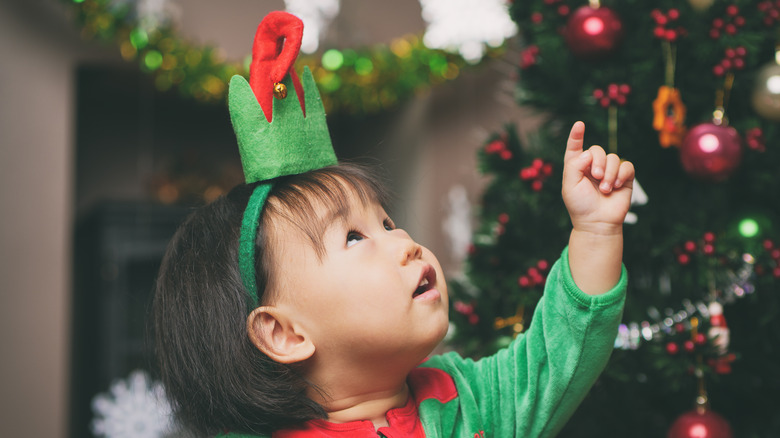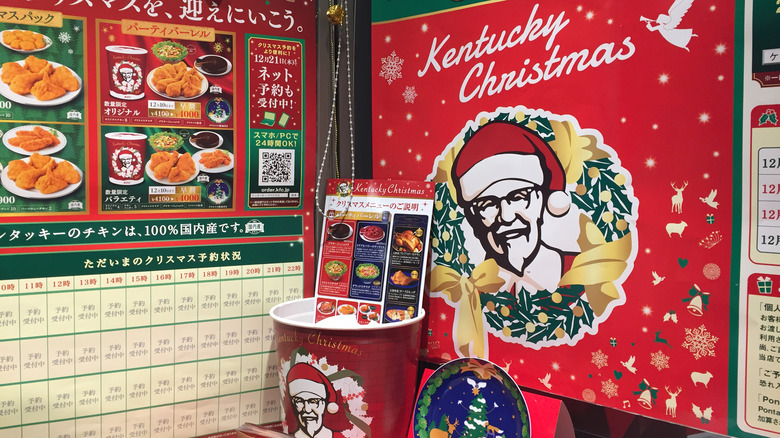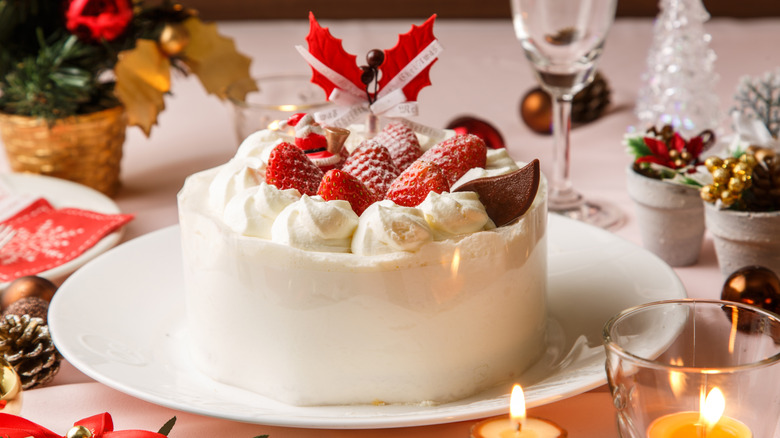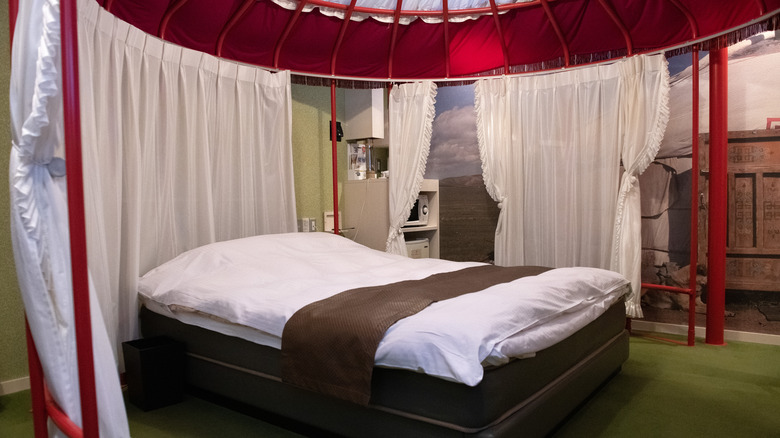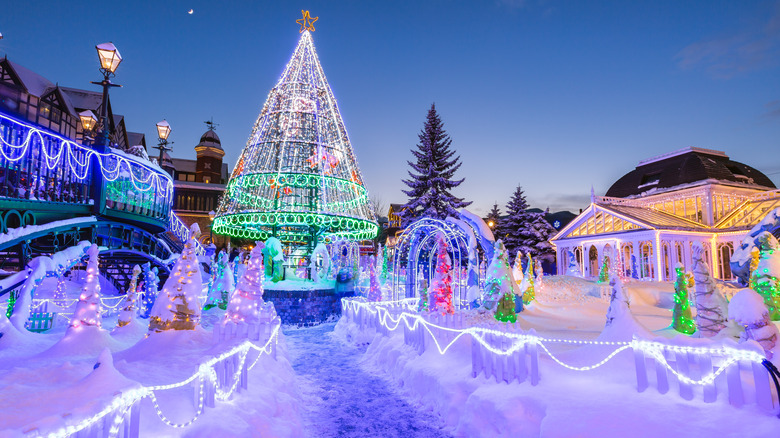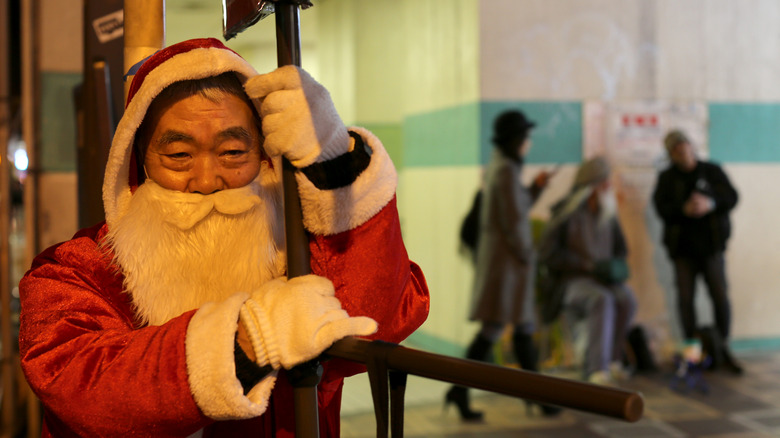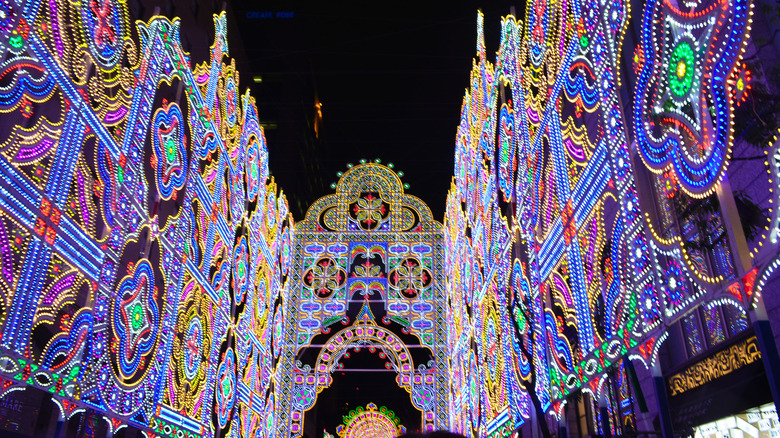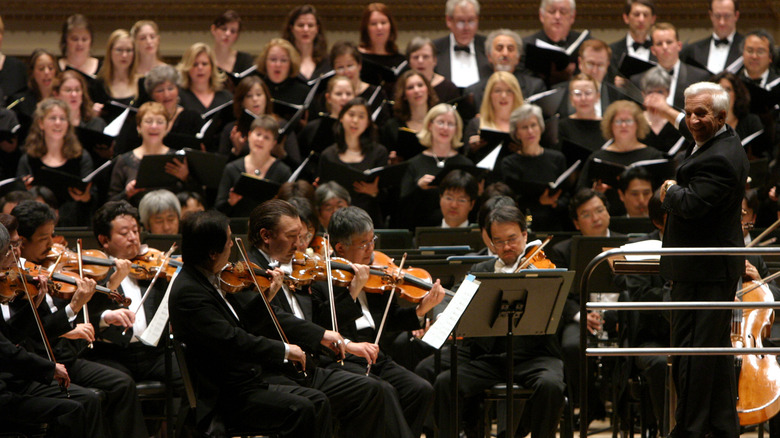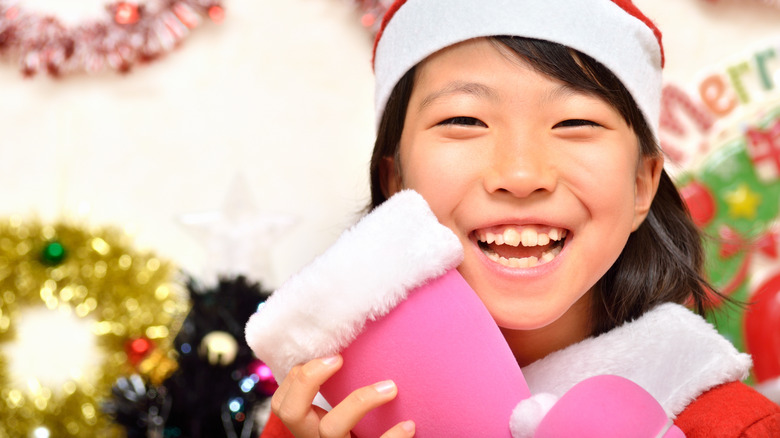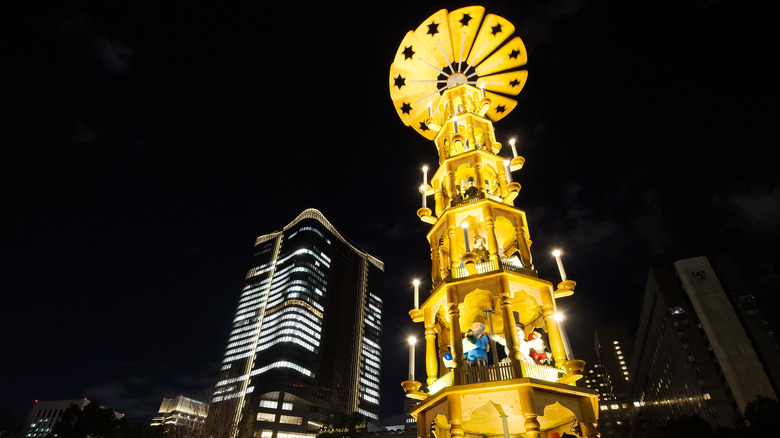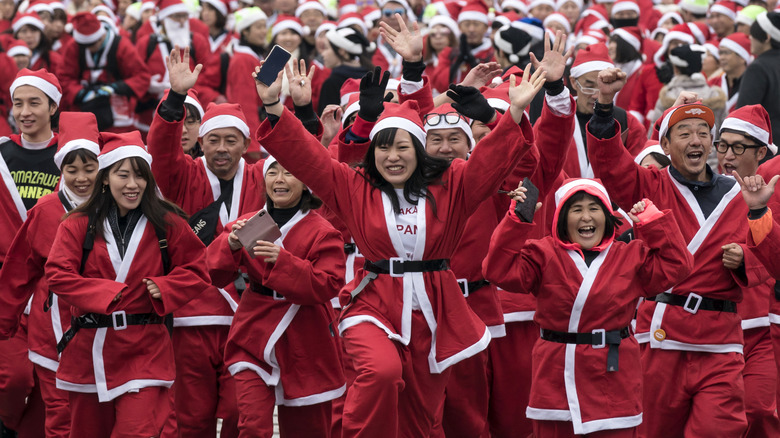Unique Ways People Celebrate Christmas In Japan
From paper ring countdowns to letters to Santa, too many time-honored traditions surround the Yuletide to enumerate. And that's just stateside. When you explore the holiday through a global lens, more fascinating traditions emerge like Europe's obsession with Santa's evil counterpart, Krampus, and Iceland's preponderance for binge reading books and eating chocolate all Christmas Eve night.
But it's tough to beat Japan when it comes to offbeat and creative ways to do Christmas. Although the "Land of the Rising Sun" hasn't declared it a national holiday, that doesn't stop locals from participating in quirky celebrations. Some prove quite traditional in Western eyes, including tree displays and illuminated light shows. But others might leave you scratching your head, like KFC Santa and upticks in visits to love hotels.
Nevertheless, these ways of observing the holiday come with their unique charms, and you may find yourself tempted to adopt some of them for yourself. Here's what you need to know about celebrating Christmas in true Japanese style.
Celebrating Kentucky for Christmas
Since the 1970s, a curious thing has happened in Japan. Kentucky Fried Chicken has become synonymous with a traditional Japanese Christmas celebration (via Business Insider). Nothing exudes the Yuletide spirit like tucking into a family-size fried chicken meal. The finger-licking-good craze got started in the 1970s with a clever marketing ploy by Takeshi Okawara, the first manager of the franchise in Japan. By 1984, he acted as CEO of KFC's Japanese franchises and would remain at the helm through 2002.
Okawara started by marketing a "party barrel" inspired by America's penchant for lavish holiday meals like Thanksgiving. But instead of turkey as the center point, he swapped it with fried chicken. He called the promo pack "Kurisumasu ni wa Kentakkii," which translates to "Kentucky for Christmas." The clever campaign resounded with locals, as did Okawara's appropriation of Santa Claus as a brand symbol.
"Kentucky for Christmas" proved a brilliant marketing move and one that "filled a void," according to Associate Professor of Marketing Joonas Rokka of France's Emlyon Business School. After all, Japan didn't have much in the way of Christmas traditions. But KFC gave them a celebration game plan: "At Christmas, you eat chicken." Clearly, the message has stuck.
Nixing the gingerbread for strawberry cake
Nothing says Christmas like gingerbread cookies and fruit cake. But for those living in Japan, the Yuletide season comes with a special Christmas cake known as Kurisumasu Keki (via The Spruce Eats). This strawberry cake (aka strawberry shortcake) showcases heaps of ripe strawberries with moist sponge cake and whipped cream. For Westerners, the cake marks a delightful departure from traditional fare, like heavy plum pudding or rich fruit cake.
While you might feel tempted to think of this cake as more of a spring dessert, the compulsory Santa Claus decoration on top of each cake provides the perfect reminder of the season. If you assume the symbolism of the cake stops there, think again. According to Smithsonian Magazine, the white color evokes rice, and the red hue fights off malevolent spirits. (It's no coincidence that Japan's flag bears the same colors.) The round shape is even evocative of another Japanese dessert, mochi.
Japanese Christmas Cake made its debut after World War II, promoted by Fujiya Company, a confectioner in Japan. The decadent sweet proved a miracle of modern technology. After all, its fresh whipped cream icing required refrigeration, which coincided with the introduction of affordable and accessible personal refrigeration. And the ability to purchase fresh strawberries out of season stemmed directly from improved post-war supply chains. Today, cake exchanges occur across the nation, as reported by Snopes, marking a decidedly delicious upgrade to stateside fruit cake gift-giving.
Putting the 'kink' in Christmas with love hotels
Remember the saying, "Jesus is the reason for the season"? For the Japanese, Christmas is all about lovers rather than Christianity, as The New York Times reports. So, it's little surprise that Christmas Eve remains the busiest day (and night) of the year for Japanese hotels, and more specifically, love hotels. Think of love hotels as a nice name for hourlies stateside, where you can pay for a few hours of passion without getting stuck with a whole night's bill.
Once upon a time, these so-called love hotels included kinky amenities such as manacles, mirrors, and rotating beds, per Forbes. Some also included thematic decorating to imitate caves, classrooms, or subway trains. Think "Fifty Shades of Grey," the Christmas edition. But regulations in the 1980s took much of the spice out of these joints, Forbes notes, drawing on information from Ed Jacob's book "Love Hotels."
Nevertheless, districts within Osaka continue to keep the love hotel lights burning, and they remain synonymous with Christmas. Love hotels in Osaka include everything from vending machines filled with lotions and sex toys to complimentary costume rentals. For the ultimate Christmas experience, there's the Nihonbashi Little Chapel Christmas, which, as the name suggests, contains plenty of decorative shoutouts sure to make your Christmas merry. But you'll need to book well in advance for a few hours of pleasure on Christmas Eve as the hotel sells out rapidly. Despite the crackdown, the Japanese continue to put the XXX in Xmas.
Going public with seasonal Christmas decor
Decorating and displaying Christmas trees in private homes proves uncommon in Japan. But no expense is spared for lavish and dazzling public lighted tree displays (via Japan Rail Pass). Bedecked evergreens often appear at shops and commercial centers, enticing locals to embrace other aspects of the holiday, including the commercial merriment.
These decorative manifestations stay up throughout December and into the New Year. Tokyo plays home to many of these seasonal displays. They include the Ruffle Christmas Tree Dress located at the eternally fashionable hotel The Tokyo Edition, Toranomon. There's also the Wa-Yo Fusion tree, designed by itu', a Japanese ex-pat to Paris. Located in the Andaz Tokyo hotel's lobby on the 51st floor, this seasonal show stopper's worth a trip to the top, according to the hotel's Instagram page.
For Christmas revelers who might be looking for something a little different, there's the 23-foot-tall Christmas tree at Ometosando Hills (via Omotesando Hills). In keeping with its 2021 theme "100 twinkle sounds ~ Fanfare for the future," Ometosando Hills decked its tree out with 100 different musical instruments interspersed with fluffy metallic balls. Best of all, it plays a synchronized two-minute-long music and light show every 20 minutes, imbuing passers-by with a bit of good cheer.
Santa remains the guest of honor for kids
Although many aspects of Christmas never made their way over the ocean to Japan, to the delight of small children, Santa has. Known as Santa-san or Mr. Santa, he brings gifts, just like his Euro-American counterpart (via Hyper Japan). But not all cultural concepts transfer over perfectly.
For example, the nation, which is less than 2% Christian, has faced scrutiny for tone-deaf Christmas displays such as one that allegedly featured Santa nailed to a cross. In the nation's defense, Snopes has thrown some shade on the veracity of this story.
Apart from the potential bastardization of Christmas traditions, Santa serves similar functions in Japan, visiting homes to leave gifts for children despite a dearth of chimneys. But the award for most innovative Saint Nick-related display must go to Tokyo Aquarium. For the past two decades, Santa has made special appearances decked out in scuba gear and swimming with the dolphins, as reported by Hyper Japan.
Illuminations and light shows make the season bright
You'll find light festivals everywhere during the holiday season, adding touches of warmth and illumination during what can sometimes feel like a cold and bleak time of year. According to Japan Rail Pass, Tokyo contains some of the best displays and shows in the nation. And many of these luminescent events persist well after the New Year. For example, the Country Farm Tokyo German Village stuns with more than 3 million LED lights, showcasing a 230-foot-long tunnel of lights that you must see to believe. Best of all, it's open through the end of March.
Running through the end of February, the Tokyo Midtown Christmas Illumination represents another tantalizing nighttime wonderland. Among its most famous light displays is the Starlight Garden, and the area boasts other attractions locals enjoy visiting, like shops, cafes, restaurants, and museums. This mixture of amenities makes it one of the most popular illumination shows in the capital.
But the oldest and most iconic light show remains the Kobe Luminarie. Millions of visitors flock to see it each year, as reported by Atlas Obscura. It memorializes those who perished in the Great Hanshin Earthquake and represents the handiwork of Hirokazu Imaoka of Kobe, Japan, and Valerio Festi of Italy. It features more than 200,000 miniature, hand-painted lightbulbs, making it an authentic, one-of-a-kind attraction replete with a Yuletide glow.
Beethoven's Ninth Symphony is Christmas fare
Americans and Europeans usher in Christmas with everything from time-honored carols to classical music productions like George Frideric Handel's "Messiah" and Pyotr Ilyich Tchaikovsky's famed ballet "The Nutcracker." And we can't forget about crooners like Michael Bublé, who's earned himself the title the "King of Christmas," according to ET Online.
But for the Japanese, nothing says Christmas like Ludwig van Beethoven's Ninth Symphony and, more specifically, the "Ode to Joy" (via WQXR). Known as "Daiku" or "Big Nine" in Japan, the symphony also proves highly popular at celebrations of Oshogatsu (Japanese New Year), as reported by The Seattle Times.
The Beethoven tradition dates back to World War I and a group of German prisoners of war (POWs) at Tokushima Prefecture's Bando POW Camp in Naruto. According to legend, the men often performed music, and the Ninth Symphony proved a perennial favorite. After the war ended, the men entertained one last time outside the prison walls, which hooked locals. By 1940, the symphony ranked near the top of winter holiday staples, and it remains there today. Contemporary productions pull out the stops, employing thousands of choir members in some cases. These spectacular performances have helped cement Daiku's continued role as a Noel favorite (via BBC).
Gift-giving proves a complex process, even at Christmas
Although gift-giving at Christmas time doesn't have deep roots in Japan, it still comes with many etiquette rules that givers and recipients must know how to navigate. According to The Culture Trip, one of the main differences remains the sense of obligation involved in giving. An emphasis gets placed on generosity without reciprocation in the West (at least in theory).
But present exchanges in Japan remain grounded in a complicated "cycle of obligation and gratitude." In true consumer spirit, however, Japanese retailers have created a wide variety of appropriate gifts, especially for catering to the holiday spirit. After all, what the Japanese anticipate receiving at Christmas differs from the expectations of Euro-Americans. For starters, practical and useful gifts take precedence over hand-picked or highly meaningful ones. In other words, pantry staples like Spam often prove more desirable than more personalized items like pajamas or scarves.
When receiving gifts, the recipient should refuse the gift twice before accepting it on the third round (via DHC Beauty). And they should take the package with both hands as a sign of respect. It's also important to remember that package wrapping is highly ritualized, from giving an auspicious number of packages to ensuring they're professionally wrapped. According to "Asian Business Customs and Manners: A Country-by-Country Guide," polite recipients consider the wrapping an actual part of the gift and keep the paper intact when unwrapping as a sign of respect.
Boots get stuffed instead of stockings
Another difference that might take some getting used to is the Japanese concept of a Christmas stocking. Unlike the large (and often stretchy) Western contraptions designed for maximal stuffing with candy and toys, the Japanese often give Christmas boots.
Like stockings, these gifts for children can contain a myriad of fun snacks, from hard candies and cookies to potato chips, all contained neatly in a plastic mesh. As explained in a video featuring these festive boots, many will also despict popular cartoon characters on the boot's exterior packaging.
Starbucks Japan even unveiled a Santa Boots Chocolate Frappuccino for Christmas 2019 to commemorate this tradition (via Japan Today). As you may have guessed, the Frappuccino contains ingredients meant to evoke opening a Christmas boot, including chocolate bits, salty potato chip topping, and a cookie straw. The boots have earned an iconic status as a part of Japanese holiday culture.
Christmas markets imbue Tokyo with the vibe of old Europe
Like many other nations around the world, Japan has taken a cue from Northern Europe when it comes to Christmas markets. According to National Geographic, these events enjoy a rich and storied history in places like Germany and Northern France, attracting huge crowds who shop the stalls for unique wares. Along the way, they also enjoy opportunities to taste-test delicious food and revel in the quaint ambiance of the decorated squares. The same holds true for Japanese markets, where you'll find a mixture of local treats and European-style decorations and wares, according to TimeOut.
One of the most famous of these markets is the Tokyo Christmas Market, which features a 46-foot-tall "Christmas pyramid installation." Christmas pyramids boast a history as old as that of decorated evergreen trees. And the one situated in the Tokyo Christmas Market originated in an authentic German village.
Another market locals flock to is the Yokohama Red Brick Warehouse Christmas Market. It specializes in traditional German fare, from sausages to stollen cakes to schnitzel. Besides Teutonic eats, locals also shop the gorgeous holiday decorations, and there's even an "on-site snow globe workshop," as noted by TimeOut. Few places in Japan contain more Yuletide cheer while making visitors feel as if they've stepped foot in a German December market.
Racing with the pack at the Tokyo Great Santa Run
Every year, runners dressed in red and white Santa garb line up to participate in a holiday-inspired race through the streets of Tokyo (via Tokyo Weekender). The race is limited to a maximum of 5,000 competitors, and places sell out quickly. Competitors race along a course measuring 2.5 miles. Some runners speed by at full tilt while others leisurely walk. Although racers have a choice when it comes to how fast they move, one thing's non-negotiable: wearing a scarlet, fur-trimmed costume.
Along the way, local celebrities cheer on participants, and well-known marathon runners even show up, providing coaching advice to those involved. Organizers provide food booths, live musical performances, and other entertainment. According to the New York Daily News, the race benefits children who are hospitalized, providing funds to purchase a Christmas present for each one.
Of course, the Tokyo Great Santa Run doesn't claim to be the only event of its kind in the world. Santa runs have become popular in many other corners of the globe, too. They're hosted everywhere from Moscow to North Macedonia's Skopje (via The Jerusalem Post). Although it's not the most unique facet of Japan's Yuletide celebrations, the race remains a vital part of racing into the holiday season.
